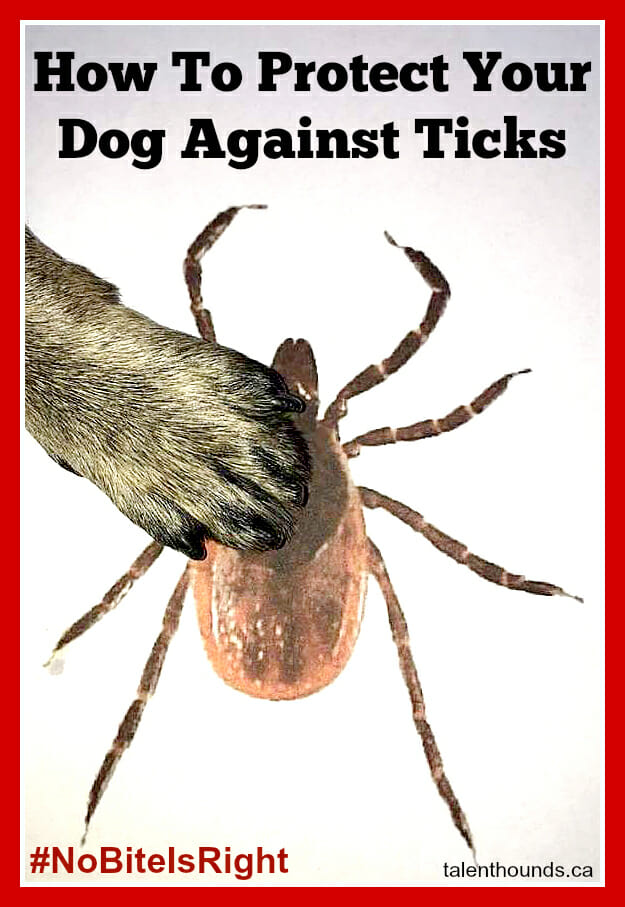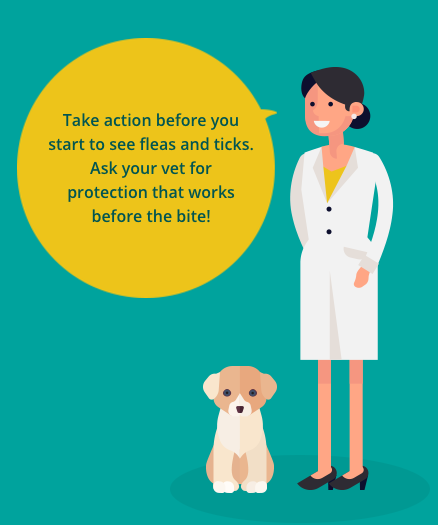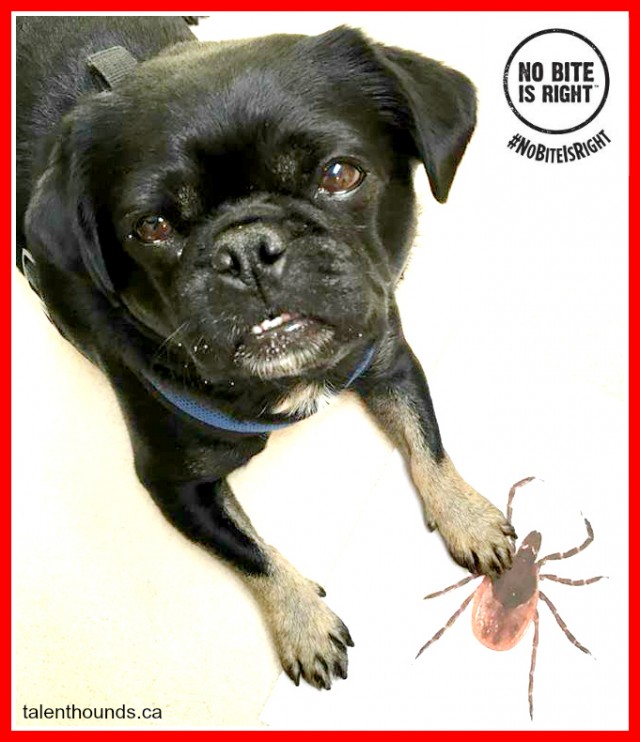As the weather finally warms up, that means more walking and playing outdoors. However, it can also mean more danger of flea and tick bites. I thought Kilo the Pug was pretty safe in downtown Toronto but I was wrong.

Lats week we were pleased to announce that our pal, Crusoe the Celebrity Dachshund, is the spokesdog for the No Bite Is Right Campaign.
Check out our exclusive behind the scenes interview with him when he came to Toronto for his photo shoot below. Read our full behind the scenes post HERE.
This post is sponsored by the “No Bite Is Right” Campaign. We have been compensated to help share their message, but we only share information we think will be useful for our readers. Talent Hounds always recommends consulting your vet when it comes to your pet’s health and wellness.
#NoBiteIsRight Campaign
No Bite Is Right™ is a national awareness campaign that aims to educate pet owners on flea and tick bite prevention. Dog owners are encouraged to talk to their vets about the differences between systemic (e.g. oral medications) and non-systemic(e.g. topical) types of flea and tick medications so they can make informed decisions for their pets.

After Crusoe was bitten, (read his story HERE), he joined the fight against ticks and is helping to spread awareness to keep other dogs safe. Inspired by Crusoe and this campaign, we took a look at just how dangerous ticks can be and what we can all do to protect our dogs from bites.
According to the 2016 U.S. Centers for Disease Control and Prevention study, there are about 200 species of ticks in North America alone. These creepy parasites feed off your dog and carry the bacteria that causes Lyme disease and other harmful diseases. Various species of ticks have been found carrying Babesiosis, Anaplasmosis, Ehrlichiosis, and Tick Paralysis.
“Fleas and ticks are rising concerns across Canada,” says Dr. Chancie Knights, Technical Services Veterinarian for Bayer. “It’s increasingly important for pet owners to understand that these parasites cause irritation and distress and may spread harmful bacterial and viral diseases to pets that can be fatal in some circumstances.”
The recent cases found in Toronto and all over Canada and the US are very concerning.
“Tick-borne diseases occur in all 50 US states and often cause serious illness in dogs, ranging from acute and life-threatening to chronic conditions that significantly impact a dog’s quality of life,” says Dr. Diane E. Brown, CEO of the AKC Canine Health Foundation.
What Are Ticks? Ten Tick Facts:
- A tick has a one-piece body.
- They can range from about the size of a grain of sand to as large as a human’s fingertip.
- They can be black, brown or tan.
- Ticks are part of the eight-legged Arachnida classification, like spiders.
- They use harpoon-like barbs, crab-like legs, and a sticky secretion to attach and hold on to hosts.
- Ticks will only breed while feeding on a host.
- Ticks are highly adaptable to any climate and have been found nearly all over the world.
- Ticks are usually found in woods, beach grass, lawns, forests, and even in more urban areas. They like to hang out in dense brush or tall grass “questing” or waiting for a host to pass by that they can latch onto.
- Ticks don’t jump onto their prey but rather wait to latch onto a potential host passing by during “questing”.
- One female tick can lay up to 3,000-20,000 eggs depending on the species of tick- YUK.
How Big is the Tick Bite Risk?
According to Canadian researchers, tick populations have grown 10 times over in the past two decades within Canada and aren’t slowing down. With rising concerns across Canada and North America, it’s time for pet owners to get educated and protect their pets.
I had assumed that ticks were not a big risk in downtown Toronto. However, when I heard Crusoe’s story, I began to worry about Kilo the Pug picking up one of these disgusting bugs while out on a walk. We often go to the ravine or local dog park in a wooded area. To make matters worse, I heard a Toronto vet on the radio saying they have already found several ticks carrying diseases like Lyme disease locally. Lyme disease can cause pain, fatigue, kidney failure, and even death. The disease has already been declared endemic in southern parts of British Columbia, Manitoba, Ontario, Quebec, New Brunswick and Nova Scotia. I would be devastated if he contracted it of course, and I’m not alone. A recent study found:
- 80% of Canadian pet owners are concerned with flea and tick bites.
- 79% of owners worry about disease transmission from flea and tick bites.
- 70% want protection that reduces the chances of these parasites biting their pets.
Even one tick brought into the home can lead to an infestation. According to Health Line, “a tick infestation may occur once the tick reproduces. Ticks can lay their eggs in different parts of the home. However, they typically lay their eggs in between floorboards.” Ticks found loose in the home or on the body can be vacuumed up. Then disposed of in the tightly sealed vacuum bag. There are also sprays and powder insecticides to help kill ticks inside your home. The best way to avoid bringing ticks into your home is by doing a tick check before entering your home.
Protect Your Dog From Tick Bites

Pet owners should always consult their vets to find out what flea and tick treatments are best for their pets. Currently, there are two popular types of preventative measures you can take to protect your dog.
1) Topical or Non-Systemic Products
Liquid contact kill products are applied to your dog and can actually repel, disorient, and kill the tick before it bites. Reducing the likeliness of flea and tick bites helps reduce the risk of disease transmission.
2) Oral or Systemic Products
Chewable flea and tick medications are ingested by your dog and flow through your dog’s bloodstream. However, this product requires the parasite to bite and intake enough of the medication in order to be killed, which may leave the pet vulnerable to disease.
“Once we learned about the different ways products work, we asked our vet for something that works on the outside of Crusoe because it reduces the chances of fleas or ticks biting him, which reduces the chance of him contracting diseases from their bites,” says Beauchesne, Crusoe’s owner.
I also chose a topical liquid for Kilo that I apply monthly. It seems safer that the tick doesn’t have the chance to bite.

How To Do A Tick Check
Each time you come in from a walk, always perform a quick tick check on yourself, your clothes, and your dog. Unlike other insect bites, this bite is usually painless, so you and your dog may not notice it.
Ticks like warm places on the body always check by running your fingers over your dog’s body and looking:
- between toes
- inside ears
- face area
- skin folds (if they have wrinkles)
- armpit
- groin area
If you feel a bump inspect it further to make sure a tick hasn’t attached to your dog.
See a tick on your dog?
Ticks should be removed from your dog (or human) as soon as you notice. The transmission of harmful pathogens can occur three to six hours after the initial bite. The sooner the tick is removed the less chance your dog will get sick.
It can apparently take up to a week or twenty-one days for symptoms of a tick-related disease to appear so prevention and careful inspection during tick checks are key.
How To Remove A Tick From Your Dog

I really hope to avoid bites, but just in case, as a few people asked in our last post, we did some research on tick removal. The AKC and other sites we visited and vets we talked to all seem to offer similar advice if you do find a tick and can not get immediately to your vet:
First grab gloves, sanitized tweezers, a sealable container, isopropyl alcohol and antiseptic cream.
- Spread your dog’s fur away from the tick, then grasp the tick as close to the skin as possible with the tweezers.
- Very gently, pull straight upward, in a slow, steady motion. This will prevent the tick’s head from breaking off and remaining embedded in the skin.
- Put the tick in the small container filled with isopropyl alcohol and date it.
- Clean the bite on your dog and apply an antiseptic cream.
Bring the tick body to your vet to be tested if your pet shows signs of infection or disease.
Another option for tick removal is the hook. There are several types of hooks, like the Tick Twister or the Tick Stick which replace the tweezers. The method is the same as the tweezers but you simply put the prongs on either side of the tick and twist upward in the same motion.
Avoid trying to remove the tick with your fingers. The squeezing may inject infectious material into your dog.
Via AKC- This tick expert, from the University of Manitoba, demonstrates removing a tick by letting one bite her- warning this looks pretty gross:
Symptoms To Look For After a Tick Bite
After you remove the tick from your dog, keep an eye on the bite for the next couple of days. If it looks infected contact your vet. Here are some symptoms to look for that could be a sign of a tick-born disease.
Symptoms:
- arthritis or lameness
- fatigue
- swollen joints and lymph nodes
- fever
- loss of appetite
- neurological problems
- kidney issues
- anemia (caused by a severe infestation)
- breathing difficulty
Crusoe’s #NoBiteIsRight Tour
We will be working with Crusoe, various experts and PR Company Smithcom, to help share more information and research. We will be attending the Toronto stops on the tour (can’t wait for Woofstock).


Very important information!
People are starting to find ticks in our local parks. So gross! When we go hiking where there are ticks, Mr. N gets a bath and a very thorough combing!
I absolutely despise ticks… nasty buggers. It’s been a bad spring around here for them.
What a great campaign! Thank you for sharing this important info!
Great info thanks
What great information and reminders! I always give the goldens a thorough brushing after they’ve been outside for a long time.
I HATE ticks with every fiber of my body! *Shudder* I do thorough checks on the boys whenever we go walking in the park or on trails. They are nasty and dangerous.
We HATE ticks! Gross itchy little critters! We have a constant battle here keeping all the pups free and clear of the little devils!
Wonderful post! And I love video you shared, it is so important to know how to remove them correctly! 🙂
I hate ticks so much! I’m definitely not looking forward to the summer time! Last year the dogs came home with a couple of ticks after going to the park and my husband got one too. They are so creepy!!! Great post! 🙂
Thank you for the incredibly informative post! I’m so glad this campaign is going on to help educate pet owners about the dangers of ticks. I am thankful that ticks aren’t as big of a concern as they were when I lived in Indiana (and my cats are strictly indoor-only).
This is such a great initiative! When Crusoe is finished touring Canada, maybe he can come down here and tour the US to share this vital message?
Love & Biscuits,
Dogs Luv Us and We Luv Them
Ticks creep me out! I appreciate the “how to remove ticks” video…mostly so I can show whichever friend I can rope into removing them for me should any of my dogs come home with one 😉
Such an important topic. Ticks are scary! Thanks for helping to spread the word. We hope Crusoe has huge success on his tour!
I really hate ticks! One of my dog, as well as one of my human kids, have had Lyme’s disease. Both were treated and seem okay, but I really worry about tick bites. Additionally, the same dog suffers terribly when she’s bitten by fleas, so a topical solution seems the best idea for her!
We know their are ticks in the south, but we stay in doors, so we’re pretty lucky. We do get a monthly treatment.
Thank you for sharing HOW to remove a tick safely and completely! I hadn’t thought of saving the tick to show a veterinarian if need. Great tip there!
This is such an informative article, thanks, and you’re right… #NoBiteIsRight!
Only cats here so no ticks on dogs but I have had to remove ticks from my horses. I have had a flea infestation in the past when I was a foster so I diligently practice flea control.
A friend of mine her dog has lime disease! Teak prevention is just so important! I use spot-on liquids for my dogs!!
Love x
There are so many pet owners who aren’t protecting their pets properly and these bugs are the worst! Get your dogs on a regular prevention program or else your asking for trouble!
Great campaign and great post, thank you!